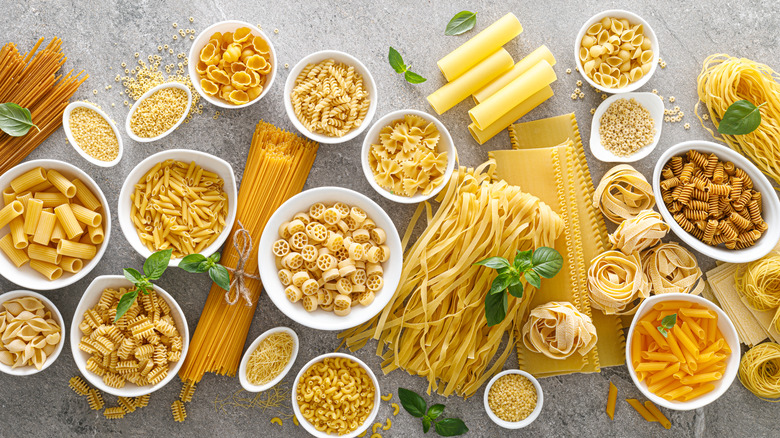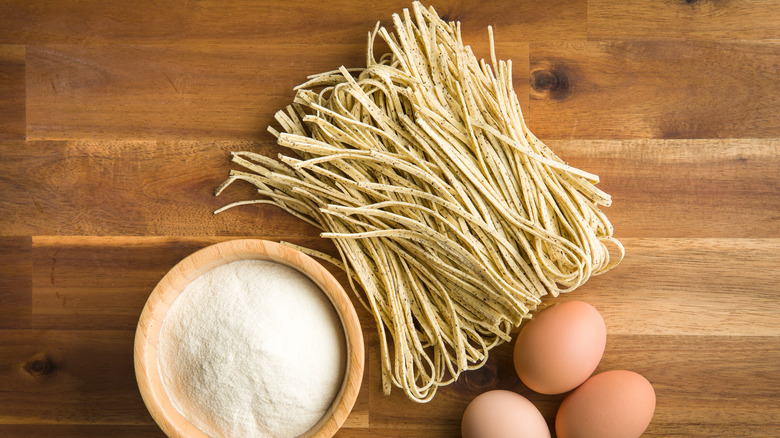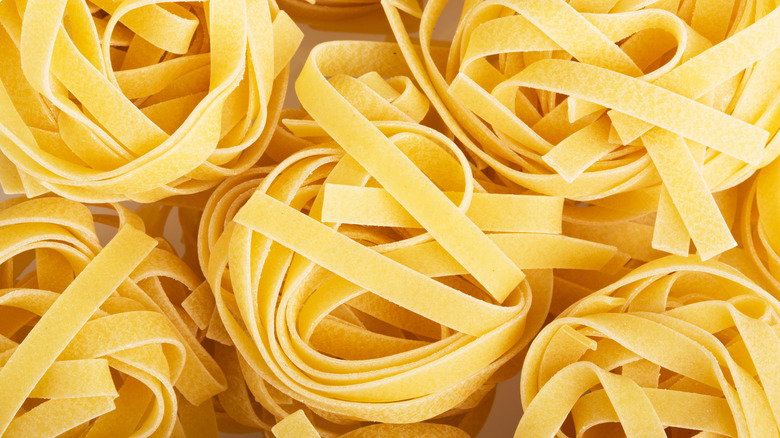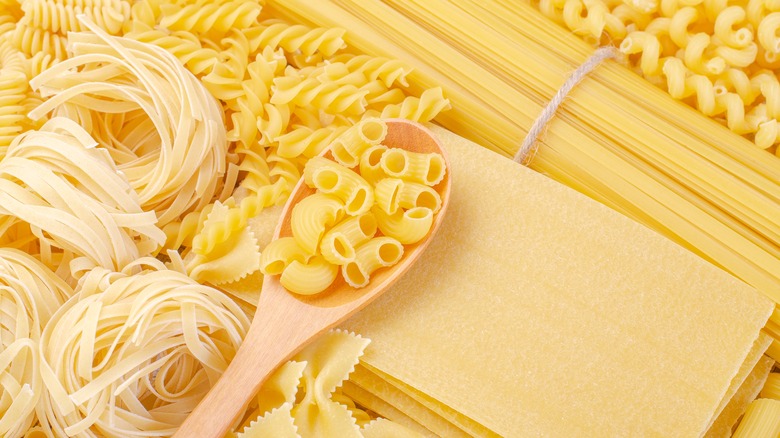Tagliolini Vs Tagliatelle: What's The Difference Between These Pastas?
Unless you're a full-fledged pasta fanatic, browsing an Italian menu or even strolling down the pasta aisle at the grocery store can be a bit overwhelming due to the sheer variety of noodles. There are literally hundreds of different types of pasta out there, but by familiarizing yourself with just a few shapes at a time you can quickly start to tell them apart. Let's start by identifying taglioni and tagliatelle. These long, ribbon-like pastas are certainly similar on the surface, but they have distinct differences that make each better suited for certain culinary applications.
To put it simply, tagliolini is much thinner and more delicate, whereas tagliatelle is wider and more robust. Like most pastas, both noodles are cut from pasta dough made from high-quality flour and egg yolks. After being rolled into a thin sheet, the pasta dough is then either fed through a pasta maker or sliced by hand to the appropriate shape. This is where the differences begin, since the shape of a noodle affects everything about it, from cooking time to best pairings.
What is tagliolini?
Tagliolini comes from Piedmont in northwest Italy. It is long and extremely thin, with a delicate and fine texture that sets it apart from other ribbon pastas like spaghetti. Both tagliolini and tagliatelle both come from tagliare, which is Italian for "cut." This refers to how the pastas are cut into thin strips. Tagliolini is thinner than tagliatelle, resembling a flattened version of spaghetti, often measuring just 1 to 3 millimeters in width. Compared to tagliatelle, tagliolini has a slightly cylindrical shape, which means there isn't a lot of space for heavy meat or other toppings to adhere to. The fragile structure of this pasta makes it ideal for sauces that won't weigh down or break it. Classic pairings for tagliolini include simple broths, sage cooked in butter, or seafood sauces.
Since it's so thin, tagliolini cooks very quickly — we're talking two to three minutes — making it a favorite of busy home cooks. The pasta's subtlety allows it to blend with its sauce, so it's the noodle to reach for if you want to show off a dish with carefully crafted flavors or especially impressive ingredients.
What is tagliatelle?
Tagliatelle hails from the Italian regions of Bologna and Emilia-Romagna. It is a broader, flatter ribbon pasta, similar to fettuccine. Similar to tagliolini, tagliatelle is usually made from a flour and egg dough. This noodle is noticeably wider; each strand is cut to around 6 to 8 millimeters in width. With its greater thickness and substantial texture, tagliatelle holds up well to more robust sauces like pesto, marinara, or creamy mushroom sauce. Since there's more material, it takes longer to cook tagliatelle, around 7 to 10 minutes.
The wide sturdy noodles are perfect for meat-filled dishes like ragù and Bolognese. The broader shape of tagliatelle creates a foundation for thick sauces, allowing tons of flavor in every bite. Tagliatelle is a very versatile pasta. Its ability to pair well with both meat-based and creamy sauces makes it an excellent pasta for home cooks to keep on hand. Unlike tagliolini, which is best for light and subtle pairings, tagliatelle is ideal for those seeking a more satisfying and filling dining experience. If that sounds like you, check out this tip for making pasta extra rich.
Choosing between the two
When deciding between tagliolini and tagliatelle, the choice ultimately boils down to the type of dish you want to create. Tagliatelle is the pasta to reach for when you're craving something hearty and comforting. Its wide, flat ribbons are built to hold up to rich, meaty sauces, making it perfect for dishes that focus on depth and bold flavors. It has a satisfying, chewy texture that goes great with hearty, comforting meals.
Tagliolini, on the other hand, is ideal for lighter, more delicate dishes that emphasize subtle flavors and can be cooked very quickly. It has a silky, soft texture that works well with more refined sauces. It is an excellent option when you want the pasta to play a complementary role rather than dominate the dish. At the end of the day, the main differences between taglioni and tagliatelle are the shape and texture, but both are delicious and worth giving a shot. Of course, there are many obscure pasta shapes out there that all serve different culinary purposes, so it's hard to go wrong no matter what type you try.



